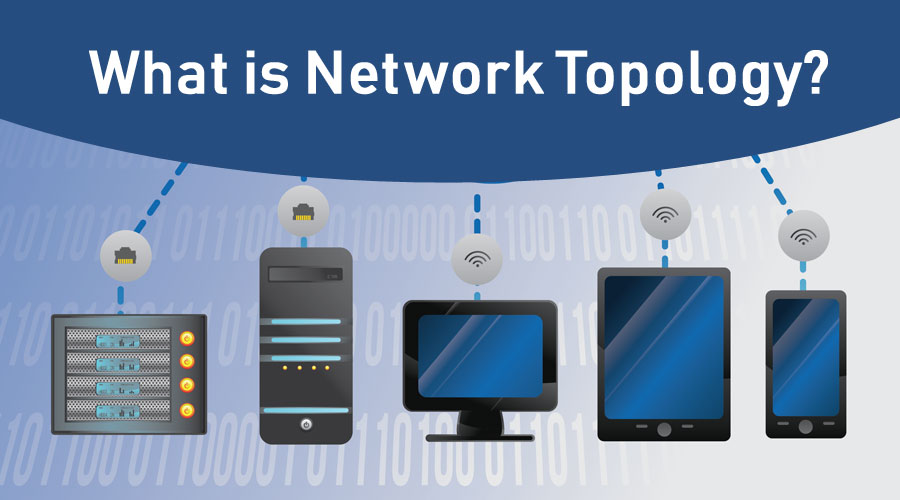What is a Network Topology?
A network topology is a diagram that shows how devices are connected. This helps administrators better understand how a network works and how to troubleshoot issues.
There are many different types of network topologies. Each one has its own advantages and disadvantages. It’s important to choose the correct one for your organization. In this article, we will discuss about Which One of The Following is Not a Network Topology.
Also Read: which technologies combine to make data a critical organizational asset
Bus
In a bus network, one cable connects all the included nodes and it is known as backbone. It is also called linear topology and the cost of this cabling is very less as compared to other topologies so it is widely used to build small networks.
The data that is transmitted through this cable reaches each node and they check the destination address (MAC/IP) to work out which node they need to communicate with. When a new node is added to the network, it is easy to add by puncturing the backbone and connecting a drop link.
This system is very simple and reliable and if any problem occurs, it does not affect the communication between the other nodes in the network. It is also scalable and easy to expand by adding new nodes.
It is also inexpensive to implement because it does not require additional cables. However, it does not work well for long distance networking.
Another disadvantage of this system is that it is slow as there are many devices that transmit through the backbone cable. This also means that there is a higher chance of signal interference and collision which may cause lag in the data transfer.
In addition to this, terminators are needed on both sides of the cable which makes it difficult to detect and troubleshoot problems. This is why a bus network is not used in modern enterprise networks.
In a bus topology, one node acts like a server and other computers act as clients. The node sends the data to the other computers and it is a linear topology.
Star
A network topology is the specific physical arrangement of the elements in a computer network. It describes the interconnections of devices to each other and how they communicate.
A star is a type of network topology where every device in the system connects to a central hub or switch. This type of topology is one of the most popular and common in computers.
It is a good choice for many organizations, as it allows for easy scalability and centralized management of the network. If there are any glitches in the performance of the individual nodes, the hub or switch can easily monitor them.
The star network is also safe to use because NIC failure or a cable cut only affects one node and does not cause a problem for the other nodes. It is also the fastest and most reliable topology as data collisions are very rare in this network.
Another advantage of this network topology is that it can be used in wireless networks. However, it has some disadvantages as well.
Compared to other network topologies, this type of network is more expensive because it requires a central hub and extra wires for connection. Fault identification and isolation in this type of network is not as easy as in the bus topology.
A star topology is commonly used in business networks, educational establishments, and home networks where high performance is required. It is particularly useful in situations where new sites need to be added quickly.
Tree
In a computer network, the topology of how the devices are connected is called a network topology. There are a few different types of topologies, each with their own advantages and disadvantages. Choosing the right network topology is important because it determines your networks performance, scalability options, and ease of maintenance.
The Point-to-point topology is the simplest and fastest to use. In this network, there is a direct connection between two computers, which allows for faster data transfer. This type of network is often used in small networks where computers are close together. It is also very reliable, as there is no need for security measures on the network itself.
One of the main reasons that this topology isn’t as popular as it once was is because of its scalability issues. Since all the computers are connected to a single cable, if one device goes down then it can disrupt the entire network.
Another issue with this type of topology is that it is difficult to troubleshoot. The failure of any one computer can disrupt the whole system and cause unwanted power consumption.
This is why most of the LANs that are in use today don’t use a ring topology anymore. It can also be quite expensive to set up and maintain.
A star topology is another type of topology that’s widely used. In this topology, there’s a central switch that connects all the other nodes in the network to it. If the central switch goes down, all the nodes connected to that switch will be affected. This makes the star topology highly reliable, but it is not cheap to use.
Mesh
A Mesh is a computer network topology that develops a P2P (point-to-point) connection between all the computers and devices in the network. This topology is very flexible and can be used to connect many different devices.
It provides a high level of redundancy for data transmission in the event that one of the connections fails. It is a common network topology for wireless networks.
The Mesh is a good choice for many applications, as it can support a massive amount of data and manage it more efficiently than other network topologies. The Mesh also offers great flexibility and scalability.
However, there are some disadvantages to using this type of network. First, it requires a complex setup and is difficult to build and maintain. It is also more expensive than other networks.
In addition, a Mesh network may not be the best choice for every application. There are a few factors to consider, including how much bandwidth is required for each device, the number of devices you need to communicate with, and the amount of power that will be needed.
Depending on the size and complexity of your application, you may be better off using another network topology. For example, if your network includes a large number of sensors, you might benefit from using star topology, which offers a point-to-point communication route between all the sensor nodes.
Another advantage of star topology is that it allows you to load balance traffic among all the nodes, which is useful when a certain node is overloaded. It is also more secure because endpoints are not connected to a central hub, which can be vulnerable to attack. It can also be a better choice if you want to avoid adding additional routers.
Hybrid
A network topology is the physical arrangement of communication devices (like routers, switches, and other computers) that connect to each other in a computer network. Several different physical network topologies are available, including bus, ring, star, mesh, tree, and hybrid.
The most common physical network topology is bus, which uses a single cable that transmits data from one end to the other in a single direction. This arrangement is less expensive to install and expand than other network topologies, but it has a number of disadvantages as well.
For example, the main cable in this topology broadcasts messages to all devices connected to it, which can cause a lot of unnecessary traffic. It also increases security risks, as devices can send a message to the main cable even when they are not intended to receive it.
In addition, there is a possibility that the main cable can break, which may result in the failure of one or more of the linked topologies. This can make the entire network fail, thereby losing connectivity and preventing users from accessing information.
Another popular physical network topology is a ring, which is a circular arrangement of computers. When a computer in the ring receives a message, it passes it to the next computer in the chain.
This method can reduce the number of transmitters and receivers on a network, reducing bandwidth requirements and limiting the risk of security issues. It also improves fault tolerance, as if one link fails in the ring, the network will still function.
Hybrid topologies are commonly employed when an organization needs to fulfill a wide range of computer networks. They are often used in schools, colleges, universities, offices, and personal and public businesses.











